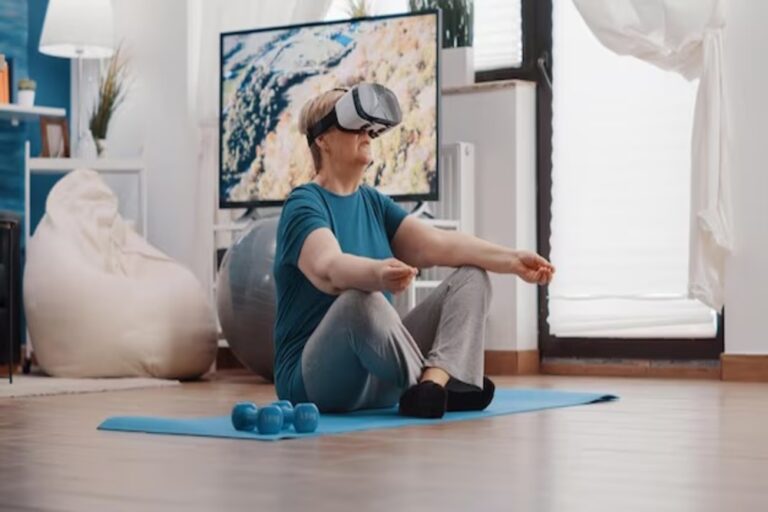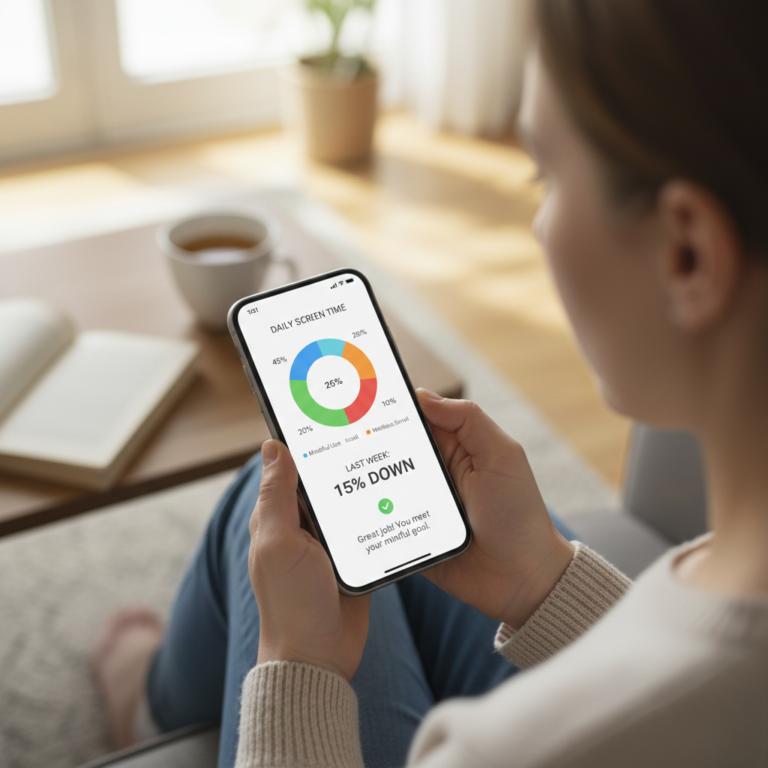
Your shoulders tense as another notification pings. The news cycle churns with fresh anxieties. Work emails flood in well past office hours. Your mind races even as your body begs for rest. In our hyper-connected world, stress doesn’t just find us—it follows us through every device we own. In our hyper-connected world in Vadodara, the constant digital noise can be a major source of stress. The simplest way to find calm is to intentionally embrace Offline Activities that ground you in the present moment.
The research paints a concerning picture: Average stress levels have risen 30% in the last decade, according to the American Psychological Association, with digital overwhelm cited as a primary contributor. Meanwhile, studies from the Journal of Behavioral Addictions reveal that the average person checks their phone 96 times daily—approximately once every 10 minutes of waking life—with each interruption triggering small but measurable stress responses.
Perhaps most telling, research from the University of California found that constant digital connectivity keeps our nervous systems in a persistent state of mild fight-or-flight arousal, even when no immediate stressor is present.
As a stress management specialist who’s worked with everyone from corporate executives to overwhelmed parents, I’ve witnessed remarkable transformations when people rediscover offline relief practices.
One chronically anxious client reduced her cortisol levels by 43% after implementing daily nature immersion. Another—a burnout-prone entrepreneur—found that 20 minutes of daily hands-on creativity dramatically improved his problem-solving abilities and sleep quality.
In this comprehensive guide, you’ll discover:
- Why digital solutions often compound the very stress they claim to solve
- The neurological benefits of offline activities for your overstimulated brain
- A practical 30-day blueprint for incorporating stress-relieving offline practices
- 50 evidence-based offline activities that promote genuine relaxation and renewal
- How to maintain these practices even in a demanding, always-connected world
By the end of this journey, you won’t just understand the science behind offline stress relief—you’ll have experienced the profound difference it makes in your mental, emotional, and physical wellbeing. Let’s begin reclaiming the calm your mind and body naturally seek.

Understanding Why Offline Activities Are Superior for Stress Relief
The most effective antidote to modern stress isn’t found in another app or digital solution—it lies in reconnecting with fundamental human experiences.
Our stress response system evolved over millions of years to handle immediate physical threats, not the chronic psychological pressures of digital life. When we encounter stressors—whether real or perceived—our bodies release cortisol and adrenaline, preparing us for action. Yet modern digital stressors rarely provide opportunities for the physical completion of this stress cycle, leaving our systems perpetually activated.
Research from the American Institute of Stress demonstrates that digital interactions trigger stress responses similar to in-person conflicts but provide none of the physiological resolution that offline activities offer. Each notification, negative news item, or work email activates our sympathetic nervous system, but scrolling or typing provides no physical pathway to complete the stress response cycle. The result is a state neuroscientists call “chronic low-grade activation”—not intense enough to notice immediately, but profoundly damaging over time.
What makes offline activities uniquely effective for stress relief is how they engage our bodies and senses in ways digital experiences cannot:
| Offline Advantage | Stress-Relief Mechanism |
| Full sensory engagement | Activates parasympathetic nervous system through multiple sensory channels |
| Physical movement | Metabolizes stress hormones through muscular action |
| Natural environments | Exposure to negative ions and natural stimuli reduces cortisol production |
| Social connection | Face-to-face interaction releases oxytocin, a natural stress reducer |
| Focused attention | Single-tasking reduces cognitive load and mental fatigue |
Why is offline relief more crucial than ever? As our lives have become increasingly digitized, we’ve unwittingly eliminated many traditional stress-relieving activities. Previous generations naturally incorporated movement, nature exposure, and sensory engagement into daily life.
Today, the average American spends 93% of their time indoors and sits for approximately 10 hours daily, creating an unprecedented disconnect from stress-regulating experiences that were once unavoidable.
By understanding these dynamics, we can see that offline stress relief isn’t a luxury or nostalgic preference—it’s a biological necessity for our nervous systems.
10 Warning Signs You Need More Offline Stress Relief
Recognizing when your stress management approach has become digitally dependent is essential for recalibrating. If these signals sound familiar, increasing offline relief activities may be particularly beneficial:
- Digital solutions leave you more agitated than relaxed – Meditation apps, stress trackers, or wellness content paradoxically increase your anxiety
- Your stress relief activities all involve screens – Most of your relaxation involves streaming, scrolling, or digital entertainment
- You feel uncomfortable with stillness or silence – Quiet moments without stimulation trigger restlessness or anxiety
- Your stress symptoms intensify in the evening – Headaches, tension, or rumination increase after day-long digital engagement
- You’ve stopped engaging in previously enjoyable physical activities – Former interests in movement, crafts, or outdoor recreation have been replaced by passive consumption
- Your sleep is disrupted despite digital solutions – Sleep apps and trackers haven’t improved persistently poor rest
- You feel temporarily better but not fundamentally restored – Digital escapes provide momentary relief without lasting renewal
- Your stress management feels like another obligation – Wellness has become another digital task to optimize rather than an experience to enjoy
- Your relaxation requires increasingly intense stimulation – Needing more extreme content or faster-paced media to feel engaged
- You struggle to remember when you last felt deeply relaxed – Genuine calm has become an elusive or forgotten state
How many of these warning signs resonate with your experience? If three or more feel familiar, prioritizing offline stress relief could transform your physical and psychological wellbeing.
Preparing for Effective Offline Stress Relief
Successfully incorporating offline practices requires thoughtful preparation, not just good intentions. Creating the right conditions dramatically increases your chances of experiencing genuine relief and maintaining these practices long-term.
Understanding Your Personal Stress Patterns
Begin by identifying your specific stress signature and relief needs. Research from the Stress Management Society shows that personalized approaches increase effectiveness by 60% compared to generic stress management techniques.
Reflect on:
- When during the day your stress typically peaks
- Which bodily sensations signal your stress activation
- What specific thoughts accompany your stress states
- Which environments make you feel naturally calmer
- What sensory experiences have historically soothed you
“Understanding your unique stress pattern is like having a personalized map for relief,” explains Dr. Amelia Nagoski, co-author of ‘Burnout: The Secret to Unlocking the Stress Cycle.’ “Generic approaches often fail because they don’t address your particular nervous system’s needs.”
Creating an Environment That Supports Offline Relief
Your physical surroundings significantly impact your ability to engage in stress-relieving activities. Harvard research demonstrates that environmental design influences stress-relief behavior more strongly than willpower or intention.
Implement these environmental modifications:
- Create dedicated spaces for offline activities – Even a small corner designated for non-digital relief
- Make stress-relief tools visible and accessible – Keep creative supplies, exercise equipment, or nature connection items prominently displayed
- Reduce friction for preferred activities – Prepare materials in advance so offline options require minimal setup
- Establish physical boundaries with technology – Create device-free zones in your home
- Design sensory-rich environments – Incorporate pleasant textures, scents, and sounds that engage non-visual senses
- Consider lighting and color – Natural light and soothing colors can physiologically reduce stress activation
“The most effective stress relief environment makes calming activities the path of least resistance,” notes environmental psychologist Dr. Sally Augustin. “When your surroundings are designed for offline engagement, your brain naturally gravitates toward the experiences it most needs.”
Overcoming Mental Barriers to Offline Activities
Many people encounter psychological resistance when attempting to engage in offline stress relief, particularly after years of digital dependency. Common obstacles include:
- Digital FOMO (fear of missing important information)
- Result impatience (expecting immediate measurable outcomes)
- Relaxation anxiety (discomfort with reduced stimulation)
- Productivity guilt (feeling non-productive during relief activities)
Address these barriers by:
- Reframing offline activities as essential productivity investments rather than indulgences
- Starting with brief sessions to build tolerance for reduced stimulation
- Creating clear boundaries around “worry time” versus relief time
- Developing transition rituals between digital and offline modes
“The mind often resists what it most needs,” observes psychologist Dr. Rick Hanson. “Anticipating and planning for this resistance is essential for successful integration of stress-relieving practices.”
By thoughtfully preparing both your understanding, environment, and mindset, you transform good intentions into sustainable practices.
The 30-Day Offline Stress Relief Blueprint
Establishing effective offline stress relief practices happens through progressive implementation, not overnight transformation. This 30-day blueprint guides you through systematically incorporating these activities into your life.
Week 1: Foundation Practices (Days 1-7)
Objective: Establish basic offline relief techniques and observe their immediate impact
Actions:
- Begin each day with 5 minutes of device-free deep breathing
- Implement one completely offline meal daily, focusing on sensory experience
- Take a 10-minute nature break, regardless of weather (even viewing nature through a window helps)
- Create a evening wind-down ritual without screens (minimum 20 minutes before sleep)
- Practice a quick body scan meditation when stress arises instead of reaching for devices
- Engage in one manual activity daily that occupies your hands (cooking, organizing, creating)
- End each day by writing three observations from offline moments
What to expect: The first week often brings awareness of how reflexively we turn to devices for distraction rather than addressing stress directly. Many people report feeling simultaneously anxious and relieved during initial offline periods. By day 5-7, most notice improved sleep quality and reduced evening tension.
Week 2: Sensory Expansion (Days 8-14)
Objective: Deepen stress relief by engaging multiple senses and physical systems
Actions:
- Incorporate 15 minutes of moderate movement daily (walking, stretching, dancing)
- Experiment with different sensory stress relievers (scent, touch, sound, taste)
- Try a “sound bath” experience—immersion in non-digital soothing sounds
- Practice one meal with full sensory attention (notice texture, temperature, flavor)
- Spend time with a pet or plant, focusing on the interaction
- Engage in bilateral movement (activities crossing the body’s midline)
- Create something physical, no matter how simple
What to expect: As sensory awareness expands, many people rediscover stress relief pathways that digital life had overridden. Physical tension typically begins noticeably releasing, particularly in the neck, shoulders and jaw. Most report increased awareness of how environments affect their stress levels.
Week 3: Social and Joy Reconnection (Days 15-21)
Objective: Address the social and emotional dimensions of stress through offline connection
Actions:
- Have one completely device-free conversation daily
- Schedule an offline activity that typically brings you joy
- Practice “generous listening” with someone without any digital distractions
- Engage in light-hearted play or silliness in a physical form
- Spend time in a community space without using devices
- Share an offline meal with others, focusing on connection
- Express appreciation directly to someone without digital mediation
What to expect: Week three often reveals how much digital habits have affected relationship quality and emotional regulation. Many people experience deeper connections with others and rediscover sources of joy that had been muted by digital consumption. Laughter and positive emotions typically become more accessible.
Week 4: Integration and Personalization (Days 22-30)
Objective: Develop your personalized offline stress-relief practice for long-term wellbeing
Actions:
- Identify your “non-negotiable” daily offline stress relievers
- Create a written plan for balancing digital and non-digital stress management
- Develop environmental cues that trigger offline relief activities
- Practice combining different offline approaches based on specific stress types
- Share your learning with others to reinforce insights
- Design context-specific protocols for different stress scenarios
- Evaluate which offline activities provide the most significant relief for you personally
What to expect: By day 30, most people have identified clear patterns in what works for their nervous system and have begun integrating these practices more naturally. Many report feeling like they’ve “remembered” how to relax in ways that previously seemed inaccessible.
50 Powerful Offline Activities for Stress Relief
The most effective stress relief comes from matching specific activities to your particular needs and preferences. These approaches are organized by the core stress relief mechanisms they activate:
Physical Tension Release
- Progressive muscle relaxation scanning the entire body
- Gentle stretching focusing on stress-holding areas (neck, shoulders, jaw)
- Rhythmic walking without destination focus
- Bouncing on a stability ball or mini-trampoline
- Self-massage using simple tools like tennis balls
- “Ragdoll” shaking to release muscular tension
- Float therapy in a bathtub or float tank
- Gentle swinging in a hammock or swing
- Slow joint rotations from head to toe
- Tension release yoga targeting typical stress-holding patterns
Nervous System Regulation
- Diaphragmatic “box breathing” (4-4-4-4 count)
- Humming or singing to stimulate the vagus nerve
- Alternate nostril breathing from yogic traditions
- Cold water face immersion for 30 seconds
- Weighted blanket rest for 15+ minutes
- Barefoot contact with natural surfaces
- Rhythm-based activities like drumming or dancing
- Forest bathing (slow sensory immersion in nature)
- Heat therapy through sauna or warm baths
- Bi-lateral stimulation through alternating movement
Creative Expression
- Free-writing without purpose or editing
- Simple drawing focusing on process not outcome
- Working with clay or play-dough
- Creating collages from magazine images
- Cooking without recipes, focusing on sensory experience
- Arranging natural items (stones, leaves, flowers)
- Movement improvisation without performance pressure
- Color gradient creation with paints or pencils
- Simple woodworking or whittling
- Voice expression through humming, toning or singing
Mindful Attention
- Intentional cloud or star watching
- Bird or wildlife observation
- Candle-gazing meditation
- Mindful walking focusing on each step’s sensation
- Tea ceremony with complete attention
- Sensory scavenger hunt in a natural environment
- Single-task cooking with full sensory engagement
- Detailed observation drawing of natural objects
- Labyrinth walking (or tracing finger labyrinths)
- Mindful photography without sharing or posting
Connection and Joy
- Physical play with children or pets
- Non-competitive sports focused on enjoyment
- Nature volunteering (trail maintenance, gardening)
- In-person skill sharing or learning
- Live music creation or appreciation
- Dance in any form without performance pressure
- Shared meal preparation without devices
- Physical acts of service for others
- Community gardening or nature stewardship
- Laughter practices or silly physical games
The most effective approach is selecting activities that appeal to your preferences while addressing your specific stress patterns.
“The body already knows how to release stress—our job is simply to create the conditions that allow that natural process to occur,” explains Dr. Herbert Benson, founder of Harvard’s Mind/Body Medical Institute. “Different pathways work for different people, but all effective stress relief ultimately engages our innate relaxation response.”
Creating a Sustainable Offline Relief Practice
The goal isn’t temporary stress management but lasting integration of relief practices into daily life. After your 30-day foundation, here’s how to maintain these approaches long-term:
The Minimum Viable Stress Relief Practice
Even during your busiest periods, certain foundational elements preserve stress resilience. Research from the Center for Mindfulness suggests these core practices:
- Brief breathing resets – Three deep breaths before transitions or challenges
- Nature micro-doses – Even 40 seconds of viewing natural scenes reduces stress activation
- Movement snacking – Short movement breaks (2-3 minutes) throughout the day
- Sensory anchoring – Keeping a physical stress-relief tool accessible (stress ball, smooth stone)
- Tech-free transitions – The first and last 10 minutes of each day remain unplugged
“These five micro-practices serve as stress ‘circuit breakers’ that prevent accumulation,” explains stress researcher Dr. Elissa Epel. “When maintained consistently, they help maintain physiological regulation even during demanding periods.”
Creating Context-Specific Stress Relief Protocols
Different stress triggers require tailored approaches. Develop specific protocols for:
- Acute work stress – Immediate interventions for deadline or conflict stress
- Chronic background stress – Daily practices for ongoing life pressures
- Relationship tension – Approaches that support emotional regulation during interpersonal stress
- Environmental overwhelm – Methods for managing sensory or information overload
- Existential or uncertainty stress – Practices that provide meaning and grounding
“The most resilient individuals have different stress relief gears rather than a single approach,” notes psychologist Dr. Ethan Kross. “They match the intervention to the specific stressor they’re experiencing.”
Modeling Stress Relief for Others
Your relationship with stress management influences those around you more powerfully than any advice you could offer. Whether at home, work, or in your community, your offline practices create permission and possibility for others.
For Families and Households
Children and partners internalize stress management primarily through observation rather than instruction. Research from family systems psychology demonstrates that one member’s stress regulation practices influence the entire household’s nervous system functioning.
Effective family approaches include:
- Creating family stress-relief rituals that everyone engages in
- Designating device-free zones and times for authentic connection
- Normalizing stress acknowledgment and proactive management
- Making stress-relief tools accessible to all family members
- Discussing how different activities help different family members
For Workplace Environments
Organizational stress culture starts with individual behavior. Studies from organizational psychology show that team stress patterns tend to mirror those modeled by respected team members, regardless of hierarchical position.
Impactful workplace practices include:
- Taking visible offline breaks rather than working through lunch
- Creating environmental cues that support others’ stress management
- Normalizing stress relief as performance enhancement rather than weakness
- Initiating walking meetings or movement-based interactions
- Respecting others’ boundaries around availability and response times
“The most powerful stress management program is seeing others prioritize their wellbeing,” explains workplace researcher Dr. Emma Seppälä. “Permission by example changes culture more effectively than any policy.”
Troubleshooting Common Offline Stress Relief Challenges
Even with thoughtful preparation, obstacles will emerge when establishing new relief practices. Here’s how to navigate the most common challenges:
“I don’t have time for offline stress relief activities.”
Solution: This perception often stems from viewing stress relief as separate from daily activities rather than integrated within them. Focus first on “activity stacking”—adding stress-relief dimensions to existing activities (mindful showering, breathing during commutes, sensory awareness while doing routine tasks). Create “micro-interventions” as short as 30 seconds that interrupt stress cycles without requiring significant time investment. Remember that effective stress management ultimately creates time by improving cognitive function, decision-making, and efficiency—invest minutes to gain hours.
“My environment makes offline stress relief difficult.”
Solution: Even challenging environments contain possibilities for micro-relief practices. Identify the smallest possible environmental modifications: a desk drawer with a stress-relief tool, a nature image as your phone background, a specific seat designated for mindful moments, or headphones that create auditory space. Create portable stress-relief anchors that travel with you (smooth stone in pocket, essential oil on wrist, specific breathing pattern). For highly constrained environments, bathroom breaks often provide the most reliable private space for brief reset practices.
“I feel selfish prioritizing stress relief with so many responsibilities.”
Solution: Reframe stress management as fundamental maintenance rather than optional self-indulgence. The research is unequivocal: effective stress regulation improves cognitive performance, decision quality, emotional availability, and physical health. Ask yourself: “Who benefits when I’m operating from a regulated versus dysregulated state?” Create a concrete list of how stress affects your performance in key roles. Consider whether you would view basic maintenance for others (children, employees, friends) as selfish or necessary, and extend the same perspective to yourself.
“I start stress relief practices but can’t maintain consistency.”
Solution: Inconsistency often results from seeking perfect conditions rather than adaptable practices. Focus on establishing “good enough” stress management that flexes with changing circumstances rather than rigid ideal protocols. Implement the “never miss twice” rule—if you miss a day, prioritize immediately reengaging rather than waiting for perfect conditions. Use existing habit anchors by attaching brief stress-relief moments to reliable daily activities (tooth brushing, coffee making, entering/exiting your home). Most importantly, practice self-compassion when patterns are disrupted—stress management is inherently imperfect because stress itself is unpredictable.
When to Consider Additional Support
If you experience:
- Stress symptoms that significantly impair functioning despite consistent self-management
- Trauma responses triggered by relaxation or body-awareness practices
- Inability to self-regulate despite implementing recommended approaches
- Physical symptoms that don’t respond to stress management techniques
Consider specialized support through stress management professionals, trauma-informed therapists, or medical evaluation of potential physiological contributors to stress symptoms. The Stress Management Society and the Association for Applied Psychophysiology and Biofeedback offer resources for finding qualified specialists.
Reclaiming Your Natural State of Calm
Stress isn’t your baseline state—it’s a temporary adaptive response that your body naturally wants to complete and release. Throughout this guide, we’ve explored how offline activities provide the conditions your nervous system needs to return to its preferred state of balanced regulation.
Consider this perspective: your body already contains all the mechanisms required for profound stress relief. The relaxation response, discovered and documented by Harvard researcher Dr. Herbert Benson, is as innate to your physiology as the stress response itself. Offline activities don’t create calm—they simply remove the obstacles preventing your natural return to balance.
The small daily choices to engage physically, sensorialy, and relationally without digital mediation collectively create powerful conditions for your nervous system to function as designed. Each offline stress relief practice is not just reducing immediate symptoms but retraining your physiological baseline toward greater resilience.
Ready to begin? Choose just one offline activity from this guide that resonates with you, practice it today, and notice not just the reduction of stress but the emergence of your natural capacity for wellbeing.
To support your journey, download our free [Offline Stress Relief Toolkit] with tracking tools, environment design guides, and expanded practice instructions to develop your personalized approach to lasting calm.
Frequently Asked Questions
Isn’t digital stress relief more efficient for busy people?
While digital solutions may seem more convenient, research consistently demonstrates they’re often less effective for fundamental stress regulation. The neuroscience is clear: complete stress cycle processing requires physical and sensory engagement that screens cannot provide. Digital solutions can supplement offline practices but rarely replace their physiological benefits.
The most efficient approach is using brief but complete offline interventions that address the root mechanisms of stress rather than longer digital approaches that may temporarily distract but don’t facilitate full cycle completion. Consider the difference between taking 3 minutes for physical movement versus 15 minutes of relaxation app use—research indicates the shorter offline intervention often provides more lasting relief by engaging the body’s natural regulation systems.
What if I genuinely enjoy and feel relaxed by digital activities?
Digital activities can certainly provide enjoyment and temporary distraction from stressors—there’s no need to eliminate these entirely. The key distinction is between temporary stress suppression versus complete stress processing. Digital entertainment often pauses stress awareness without facilitating the physiological completion needed for genuine resolution.
The most balanced approach combines thoughtful digital enjoyment with regular offline practices that engage your body’s natural stress-processing mechanisms. Consider maintaining digital activities you genuinely enjoy while supplementing with brief offline practices specifically designed to complete stress cycles—this combination often provides both immediate relief and long-term resilience without requiring digital abstinence.
How do I maintain offline stress practices in a workplace that expects constant connectivity?
Workplace expectations create real challenges for offline stress management, requiring strategic rather than ideal approaches. Focus first on legitimizing offline practices by framing them as performance enhancement rather than personal preference—research consistently shows that brief offline breaks improve productivity, creativity, and decision quality.
Start with the practices least likely to be noticed: breathing techniques during meetings, micro-movement during calls, nature views during screen breaks, or sensory awareness while walking between locations.
Gradually introduce more visible practices as their benefits become apparent. For supportive workplaces, consider proposing structured offline periods as team practices after demonstrating their impact on your individual performance.
What if I’m too stressed to engage in stress relief activities?
This common paradox—feeling too activated to activate relief—occurs because stress narrows our perceived options precisely when we need them most. For these moments, focus on the smallest possible intervention: three deep breaths, splashing cold water on your face, or 30 seconds of rhythmic movement.
These micro-practices require minimal cognitive capacity but can interrupt acute stress activation enough to enable more comprehensive approaches. Remember that stress exists on a spectrum—rather than waiting until you feel calm enough to practice stress relief, use simplified versions of these activities specifically designed for high-activation states.
The most resilient stress management approach includes both “emergency” techniques for peak stress and maintenance practices for ongoing regulation.
How do I know which offline activities are most effective for my particular stress pattern?
Personalizing stress relief requires systematic observation rather than generic prescriptions.
Begin by tracking your response to different activities across three dimensions: 1) Immediate effect—how you feel during and immediately after the activity.
2) Duration of relief—how long the benefit lasts before stress returns.
3) Contextual effectiveness—which activities work best for specific stressors versus general tension. Many people discover they need different approaches for different stress types (cognitive, emotional, physical, or existential). The most efficient method is maintaining a simple stress relief journal for 2-3 weeks, noting which activities provide the greatest impact for your particular nervous system. This personalized data typically reveals clear patterns that generic recommendations cannot capture.






